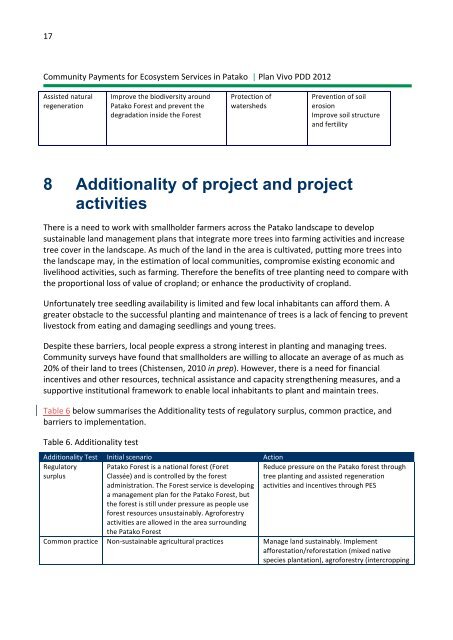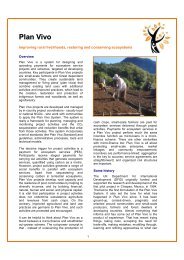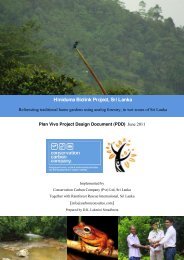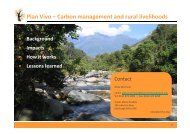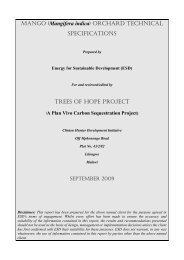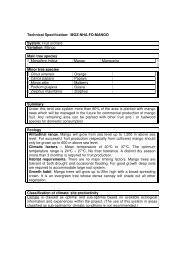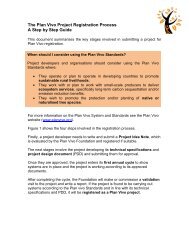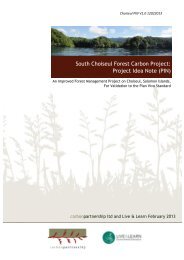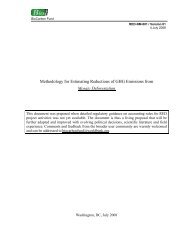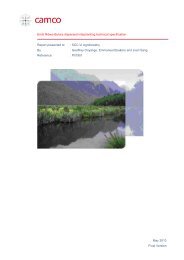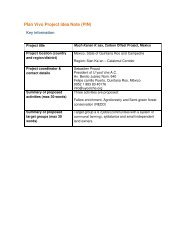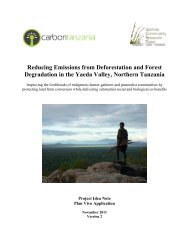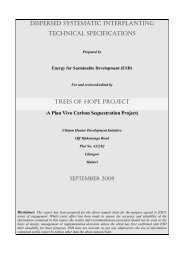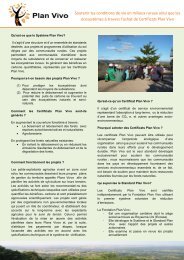Arbres locaux pour un monde meilleur | Local trees for a better world
Arbres locaux pour un monde meilleur | Local trees for a better world
Arbres locaux pour un monde meilleur | Local trees for a better world
You also want an ePaper? Increase the reach of your titles
YUMPU automatically turns print PDFs into web optimized ePapers that Google loves.
17<br />
Comm<strong>un</strong>ity Payments <strong>for</strong> Ecosystem Services in Patako | Plan Vivo PDD 2012<br />
Assisted natural<br />
regeneration<br />
Improve the biodiversity aro<strong>un</strong>d<br />
Patako Forest and prevent the<br />
degradation inside the Forest<br />
Protection of<br />
watersheds<br />
Prevention of soil<br />
erosion<br />
Improve soil structure<br />
and fertility<br />
8 Additionality of project and project<br />
activities<br />
There is a need to work with smallholder farmers across the Patako landscape to develop<br />
sustainable land management plans that integrate more <strong>trees</strong> into farming activities and increase<br />
tree cover in the landscape. As much of the land in the area is cultivated, putting more <strong>trees</strong> into<br />
the landscape may, in the estimation of local comm<strong>un</strong>ities, compromise existing economic and<br />
livelihood activities, such as farming. There<strong>for</strong>e the benefits of tree planting need to compare with<br />
the proportional loss of value of cropland; or enhance the productivity of cropland.<br />
Un<strong>for</strong>t<strong>un</strong>ately tree seedling availability is limited and few local inhabitants can af<strong>for</strong>d them. A<br />
greater obstacle to the successful planting and maintenance of <strong>trees</strong> is a lack of fencing to prevent<br />
livestock from eating and damaging seedlings and yo<strong>un</strong>g <strong>trees</strong>.<br />
Despite these barriers, local people express a strong interest in planting and managing <strong>trees</strong>.<br />
Comm<strong>un</strong>ity surveys have fo<strong>un</strong>d that smallholders are willing to allocate an average of as much as<br />
20% of their land to <strong>trees</strong> (Chistensen, 2010 in prep). However, there is a need <strong>for</strong> financial<br />
incentives and other resources, technical assistance and capacity strengthening measures, and a<br />
supportive institutional framework to enable local inhabitants to plant and maintain <strong>trees</strong>.<br />
Table 6 below summarises the Additionality tests of regulatory surplus, common practice, and<br />
barriers to implementation.<br />
Table 6. Additionality test<br />
Additionality Test Initial scenario Action<br />
Regulatory<br />
surplus<br />
Patako Forest is a national <strong>for</strong>est (Foret<br />
Classée) and is controlled by the <strong>for</strong>est<br />
administration. The Forest service is developing<br />
a management plan <strong>for</strong> the Patako Forest, but<br />
the <strong>for</strong>est is still <strong>un</strong>der pressure as people use<br />
<strong>for</strong>est resources <strong>un</strong>sustainably. Agro<strong>for</strong>estry<br />
activities are allowed in the area surro<strong>un</strong>ding<br />
the Patako Forest<br />
Reduce pressure on the Patako <strong>for</strong>est through<br />
tree planting and assisted regeneration<br />
activities and incentives through PES<br />
Common practice Non-‐sustainable agricultural practices Manage land sustainably. Implement<br />
af<strong>for</strong>estation/re<strong>for</strong>estation (mixed native<br />
species plantation), agro<strong>for</strong>estry (intercropping


